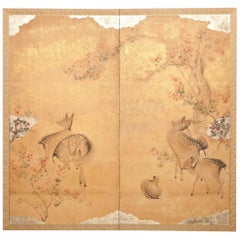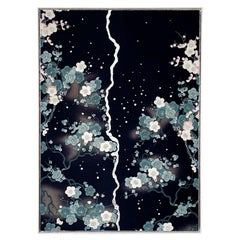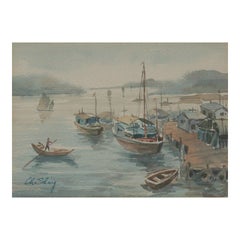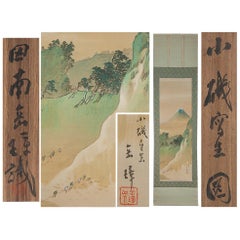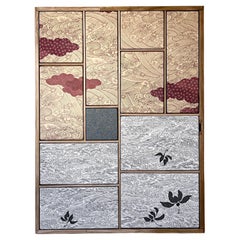20th Century Paintings and Screens
to
171
568
206
911
35
26
19
9
5
4
3
2
1
172
682
911
150
314
195
107
38
4
33
14
12
25
29
28
26
8
384
366
311
246
207
722
628
404
194
56
911
911
911
29
3
3
3
2
Period: 20th Century
Japanese Two Panel Screen Nara Deer in Gentle Yoshino Landscape
Located in Hudson, NY
Japanese two panel screen: Nara Deer in Gentle Yoshino Landscape. Yoshino is in the Nara Prefecture, an area famous for these small and tame deer native to J...
Category
Japanese Meiji Antique 20th Century Paintings and Screens
Materials
Gold Leaf, Silver Leaf
1970s, Indian Set of Three Colorful Drawings of the Royal Court
Located in Marbella, ES
1970s Indian set of three colorful drawing representing the kings royal court. Part of a large private collection.
Category
Indian 20th Century Paintings and Screens
Materials
Paper
Antique kimono textile art " Plum Blossom Night ~Resilience~ " by ikasu Japan
By Kimono ikasu
Located in Setagaya City, JP
This artwork uses antique fabric from Taisho era (early 1920ies) kimono and paulownia wood taken from antique kiritansu - chest-of-drawers used initially to keep kimonos.
It is eleg...
Category
Japanese Japonisme Vintage 20th Century Paintings and Screens
Materials
Silver Leaf
Chi Shing, 'River Boats I', Framed Watercolor Painting, China, Mid-20th C
Located in Chatham, ON
CHI SHING - 'River Boats I' - Vintage watercolor landscape painting - vintage gold tone metal frame - finished with double matte boards - signed lower left -...
Category
Chinese Chinoiserie 20th Century Paintings and Screens
Materials
Metal
Lovely circa 1900 C-Scroll Paintings Japan Artist Signed Figures in Landscape
Located in Amsterdam, Noord Holland
Title: ???? ??????? ?? ?? ?? ?? ?? ??
Condition: State is good, thin stains.
Size Axis ... vertical 216.5cm next to 56.3cm
Painting ... vertical 126.3cm horizontal 41.5cm ? diff...
Category
Japanese Taisho 20th Century Paintings and Screens
Materials
Fabric
$1,084 Sale Price
20% Off
Antique kimono textile art " Waves and clouds ~Eternity~ " by ikasu Beige, Japan
By Kimono ikasu
Located in Setagaya City, JP
This work is inspired by traditional hand-dying technique edo-komon, and is framed in paulownia wood originally used for a kimono chest-of-drawers.
It is elegantly framed with paulo...
Category
Japanese Japonisme Vintage 20th Century Paintings and Screens
Materials
Silk, Wood
Vintage Japanese Two-Panel Screen, Taisho Period, Early 20th Century
Located in Prahran, Victoria
Japanese two-panel screen, study of an Okinawan mother and child, Taisho period early 20th century, dating from the 1920's. Signed by Matsumura Baiso, (1884-1935). Baiso was a studen...
Category
Japanese Taisho 20th Century Paintings and Screens
Japanese Meiji Period Six-Panel Screen with Blue Lake and Flowers, Ca. 1900
Located in New York, NY
Japanese Meiji Period Six-Panel Screen with Blue Lake and Flowers, Ca. 1900
Meiji Period (1868-1912)
DIMENSIONS
Length: 145 inches
Height: 69.5 inches
Category
Japanese Japonisme Antique 20th Century Paintings and Screens
Materials
Wood
Vintage kimono textile art "View from the Window ~Maple&Plum~" by ikasu, Japan
By Kimono ikasu
Located in Setagaya City, JP
This work is a glorious nod to buddhist temples circle windows, with beautiful Japanese garden scape seen outside. Golden leaf on the border of a frame is an expression of light goin...
Category
Japanese Japonisme Vintage 20th Century Paintings and Screens
Materials
Gold Leaf
Early 20th century (Meiji period) crane scroll. Original storing box
Located in Fukuoka, JP
This Meji -Taisho period painting captures a serene moment in nature, depicting graceful bird resting. Painted on silk . Signed. Includes original storage box
Size: Overall 138/...
Category
Japanese Meiji 20th Century Paintings and Screens
Materials
Silk, Paper
Painted canvas representing carp. Contemporary work.
Located in Saint-Ouen, FR
Painted canvas, or decorative panel, representing carp.
Contemporary French work.
Dimensions: H 120 x W 100 cm
Reference: LS6028675A
Raw linen canvas hand painted with natural pi...
Category
French 20th Century Paintings and Screens
Materials
Copper, Gold Leaf
Japanese Antiques , Old Wrapping Paper , Tapestries , Wabi-Sabi
Located in Katori-Shi, 12
We present to you a precious old wrapping paper from the Taisho period.
This washi paper was used to wrap important items. It was made by overlapping multiple ledgers, and is chara...
Category
Japanese Taisho 20th Century Paintings and Screens
Materials
Paper
French Mashrabiya Screen
Located in Southampton, GB
French Mashrabiya style Screen.
Four panelled structure, with a Charles Dudyout design influence.
France, circa 1920.
Height - 135cm
Panel Width - 34.5cm
Total Width - 139cm
Indivi...
Category
French 20th Century Paintings and Screens
Materials
Oak
$1,703
FiVE CHINESE CH'IEN LUNG PERIOD 1736-1796 WATERCOLOUR BIRD PIANTINGS FRAMED
Located in West Sussex, Pulborough
Royal House Antiques
Royal House Antiques is delighted to offer for sale this lovely suite of five original Watercolour paintings dating to the Ch'ien Lung Period 1736-1796 publishe...
Category
Chinese Chinese Export Vintage 20th Century Paintings and Screens
Materials
Paper
Japanese Six Panel Screen, Peonies and Young Growth on Gold Silk
Located in Hudson, NY
Rimpa floral scene. Pigment on gilded silk, signature and seal read: Hattori Shunyo. Bold colors and strong design elements combined with the trademark tarashikomi (diluted elements created when water is applied to the surface before or after pigments causing them to diffuse) exhibit the artists deep devotion to this important Japanese painting tradition. Notes about artist: Hattori Shunyo (b. 1883) was an artist from Kyoto who graduated the (now) Kyoto Municipal University of Art and fell under the circle of Yamamoto Shunkyo...
Category
Japanese 20th Century Paintings and Screens
Materials
Brocade, Silk
Japanese Two Panel Screen: Pine and Mountain Landscape By Muta Akira
Located in Hudson, NY
By rivers edge at sunrise. By: Muta Akira. Mica paint on canvas. Exhibited in the 1960 Nitten exhibition.
Category
Japanese 20th Century Paintings and Screens
Materials
Canvas
Blossom and Tree Scene Meiji Period Scroll Japan 19c Artist Araki Kanpo
Located in Amsterdam, Noord Holland
If it is good enough for the Japanese emperor :)
The painting's inscription says that it was painted in the artist's 82nd year, which would be 1913.
In the early Meiji Period following the Buncho ideal of hasshu kengaku ('learning eight schools'), Kanpo expanded his talents to incorporate Western painting techniques and began studying oil painting with Kawakami Togai (1827-1881) and Kunisawa Shinkuro (1847-1877). He achieved notable recognition as an oil painter and apparently was awarded the honor of painting a portrait of the Empress Dowager. Later Kanpo returned to Nihonga and continued to receive numerous honors for his work. He received a silver medal (2nd place) at the Tokyo Prefecture Crafts Competition in 1887; 2nd place with a painting of peacocks...
Category
Japanese Meiji 20th Century Paintings and Screens
Materials
Silk
$4,953 Sale Price
20% Off
Original Pink Panther Single Cell Image
Located in Pasadena, CA
Own a rare piece of cartoon history with this authentic single animation cel from the beloved Pink Panther series. This original hand-painted cel features the iconic Pink Panther cha...
Category
American 20th Century Paintings and Screens
Materials
Glass
S. Tosuke Signed Original Japanese Watercolor Painting of Mount Fuji Landscape
Located in Studio City, CA
A beautiful, atmospheric, and quite evocative watercolor painting of Mount Fuji towering above a small misty morning village landscape by Japanese artist/painter S. Tosuke.
The wo...
Category
Japanese Taisho Vintage 20th Century Paintings and Screens
Materials
Wood, Paint, Paper
Original Pink Panther Single Cell Image
Located in Pasadena, CA
Own a rare piece of cartoon history with this authentic single animation cel from the beloved Pink Panther series. This original hand-painted cel features the iconic Pink Panther cha...
Category
American 20th Century Paintings and Screens
Materials
Glass
Lovely 20th Century Sen'yo Ogawa Scroll Painting Japan Artist Flowers Painted
Located in Amsterdam, Noord Holland
Sen'yo Ogawa
1882-1971
Japan painter. Kyoto production. Name Tasaburo. After served as apprentice of the Buddhist teacher, I learned a Movie to Chu Asai, exhibited oil paintings to...
Category
Japanese Showa 20th Century Paintings and Screens
Materials
Silk
$1,459 Sale Price
25% Off
Japanese Two Panel Screen Nihonga Style Painting of Children in Western Dress
Located in Hudson, NY
Beautiful soft painting of mineral pigments and ink on paper with a silk brocade border.
Category
Japanese 20th Century Paintings and Screens
Materials
Brocade, Silk, Paper
Hiroshige Utagawa "One Hundred Famous Views of Edo Kameido" Woodblock Ukiyo-e
Located in Amsterdam, Noord Holland
Hiroshige Utagawa "One Hundred Famous Views of Edo Kameido"
Condition
vertical width /114.5cm width /30.3Cm (actual paper) vertica...
Category
Japanese Edo 20th Century Paintings and Screens
Materials
Bronze
$849 Sale Price
20% Off
Two-panel screen of " Rinpa School"
Located in Brescia, IT
Floral scene of a Rimpa School garden with polychrome chrysanthemum flowers.
Two-panel screen painted in pigment on gilded rice paper of beautiful size and well preserved.
Bold color...
Category
Japanese Showa 20th Century Paintings and Screens
Materials
Gold Leaf
W.O.J. Nieuwenkamp (1874-1950) 'Houses in Matoer, Sumatra, 1925'
Located in Amsterdam, NL
Houses in Matoer, Sumatra, 1925
Signed with initials and dated upper centre, W.O.J.N. 30-4-25
Pencil on paper, 34 x 28.8 cm
Literature:
- Ernst Braches and J.F. Heijbroek, W.O.J. N...
Category
Indonesian 20th Century Paintings and Screens
Materials
Paper
Antique Japanese Jute and Brass Painting 'First Date'
Located in Milano, IT
Ancient and very rare Japanese painting made in the early 1900s of fine Japanese manufacture. The painting has a rectangular brass frame, with rounded corners. Internally we see an a...
Category
Japanese Anglo-Japanese Antique 20th Century Paintings and Screens
Materials
Brass
$378 Sale Price
20% Off
Actors in Dance / Theatre Scene 20th Century Scroll Painting Japan Artist
Located in Amsterdam, Noord Holland
It is a work of 2 scrolls figure in a Theatre/Dance Noh style.
it is a very tasty work combined with the hymns spelled at the top.
¦ Silk books and handwriting.
¦ State
There ...
Category
Japanese Taisho 20th Century Paintings and Screens
Materials
Silk
$2,028 Sale Price
20% Off
Vintage kimono textile art " Turquoise Forest ~Strength~ " by ikasu Blue, Japan
By Kimono ikasu
Located in Setagaya City, JP
Fabrics featuring iconic Japanese plants like chrysanthemum, maple, and bamboo were gathered from various long underwear and kimono pieces to create a set of canvases (diameter 30, 25 and 20cm) showcasing exquisite gradations.
The top canvas, in pristine white, originates from long under-kimono, while the middle and bottom canvases are skillfully upcycled from kimono fabrics.
<< Period / Story >>
The long under-kimono and kimono fabrics used in these canvases were originally crafted and worn during the late Showa period (1960-80ies).
<< Explanation and meaning of pattern and colors >>
The pattern on the top canvas features a chrysanthemum, an auspicious emblem symbolizing longevity. It is affectionately referred to as the "raccoon dog chrysanthemum" due to the large, overlapping petals resembling the fur of a muzina, a creature similar to a raccoon dog or badger. This motif is highly popular in various plant-inspired designs and frequently seen in Edo komon, katazome, and jimon textiles.
The top canvas naga-juban under-kimono, being entirely white and devoid of any additional dyes, suggests its use as formal wear. Its pristine white hue accentuates the silk's luster when exposed to light and highlights the beauty of the woven patterns.
The fabric used here is rinzu, a type of fabric thinner than crepe de chine, characterized by its soft, smooth texture and subtle sheen. This particular lintel distinguishes itself with the way its ground pattern emerges and also incorporates a woven chrysanthemum pattern.
The central canvas showcases a maple tree, symbolizing longevity, which changes its colors with the seasons, bringing joy and happiness to people's lives.
The bamboo featured on the lower canvas has been regarded as a symbol of good fortune since ancient times, given its straight and vigorous growth, along with the Chinese legend that a phoenix consumes its fruit. It embodies concepts such as "immortality," "longevity," and "strength" because it remains green even in winter. The hollow stem also signifies "innocence," suggesting that there are no hidden agendas.
All three canvases are adorned with ground patterns that, when viewed from a distance, appear as modern works of art, yet upon closer inspection, they reveal a distinct Japanese ambiance.
<< Characteristics of the fabric >>
All three canvases are made of fabrics with jimon. The unique and high level of Japanese weaving...
Category
Japanese Japonisme Vintage 20th Century Paintings and Screens
Materials
Canvas, Silk
Painted canvas representing animals on an exotic background. Contemporary.
Located in Saint-Ouen, FR
Painted canvas representing animals on an exotic forest background.
Work of contemporary French artists.
Dimensions: H 220 x W 120 cm
Reference: LS61281089I
We have another canv...
Category
French 20th Century Paintings and Screens
Materials
Gold Leaf
20th Century Silk Embroidery Chinese Decorative Panel, 1980s
Located in Vicoforte, Piedmont
Great late 20th century Chinese decorative panel. Artwork on silk and tissue, embroidered, colored and painted, depicting a landscape with fi...
Category
Chinese Vintage 20th Century Paintings and Screens
Materials
Fabric
Artists Norikuni Kawamura, Showa Period Scroll Japan 20c Artist Nihonga
Located in Amsterdam, Noord Holland
As you can see, it is a double box and a box with "Shokakuzu" written by Norikuni Kawamura.
The
"Shokaku-zu", which is composed of graceful textures, spreads its wings and flies, i...
Category
Japanese Showa 20th Century Paintings and Screens
Materials
Silk
$1,122 Sale Price
20% Off
Japanese Two Panel Screen: Mu (Nothing)
Located in Hudson, NY
Calligraphy reads: Mu (Nothing). Ink on silver in a black lacquered wooden trim. Seal is illegible.
Category
Japanese 20th Century Paintings and Screens
Materials
Silver
Japanese Two Panel Screen: Seasonal Flowers
Located in Hudson, NY
Peonies, irises, lillies, paperwhites, cockscombs, thistle and other various seasonal flowers in mineral pigmnets on mulberry paper. Oxblood lacquer trim with beautiful bronze mount...
Category
Japanese 20th Century Paintings and Screens
Materials
Bronze
Japanese Two Panel Screen Mother and Puppies Under Bamboo
Located in Hudson, NY
Mineral pigments on paper. Signature and seal read: Shigehiro.
Category
Japanese 20th Century Paintings and Screens
Materials
Paper
Italian Neo-Classical Style Landscape Painting 6-Paneled Folding Screen
Located in Queens, NY
Antique Italian Neo-Classical-style six-paneled canvas folding screen connected with brass hinges and painted with a vignette of figures at a river's edge surrounded by a painted, or...
Category
Neoclassical 20th Century Paintings and Screens
Materials
Canvas, Acrylic, Wood
Japanese Two Panel Screen Aviary Shaded by A Maple Tree
Located in Hudson, NY
Japanese Two Panel Screen: Aviary Shaded By A Maple Tree, Showa period (1926 - 1989) painting of an outdoor bird enclosure under a maple tree. Painted in ...
Category
Japanese Showa 20th Century Paintings and Screens
Materials
Silk, Wood, Paper
Vintage kimono textile art " Plum Gradation " by ikasu Pink, White, Japan
By Kimono ikasu
Located in Setagaya City, JP
This canvas featuring a plum color gradient kimono showcases a unique decorative variation of the popular seigaiha (青海波) sea waves pattern.
The artwork got a Mr. & Mrs. Abe Arts & Cu...
Category
Japanese Japonisme Vintage 20th Century Paintings and Screens
Materials
Canvas, Silk
Vintage, Calligraphy, Watercolor Paintings, Chinese Art, China, 20th Century
Located in Amsterdam, Noord Holland
A set of Chinese paintings
Perfect for vintage interiors
Condition
Yomiuri Shimbun (the size of one view double-page spread) 43.0. × 32.0 c...
Category
Chinese 20th Century Paintings and Screens
Materials
Paper
$2,405 Sale Price
20% Off
Japanese Two-Panel Screen Peony, Wisteria, Cherry and Bamboo on Soft Silver
Located in Hudson, NY
Japanese two-panel screen: Peony, Wisteria, cherry and bamboo on soft silver, Meiji period (1868-1912) painting of a garden in spring. Painted in mineral pigments on oxidized silver ...
Category
Japanese Meiji Antique 20th Century Paintings and Screens
Materials
Silver Leaf
Blue Robert Crowder Screen
Located in Los Angeles, CA
Screen by Robert Crowder. With blue background hand painted pink roses with birds and butterflies. Signed on the bottom right corner. Each in...
Category
American Vintage 20th Century Paintings and Screens
Materials
Paint
$16,000
Chinese Hardwood and Nephrite Screen
Located in London, GB
This screen, comprised of four sections and formed from Chinese hardwood and nephrite, is a beautiful piece of Chinese design—the dark lustre of the nephrite accenting the warm tones...
Category
Chinese 20th Century Paintings and Screens
Materials
Jade
Pair of Japanese Screens
Located in Schellebelle, BE
Exceptional pair of Japanese screens, 20th century
Six parts, six times 45 cm wide
Gold spotted paper with parts of old screens.
Category
Japanese 20th Century Paintings and Screens
Materials
Paper
$6,486 / set
Chinese Floral Longevity Canopy Painting, c. 1900
Located in Chicago, IL
Thoughts of a long, happy life greeted the young couple who gazed up from their bed on this canopy panel. Adorned with chrysanthemums and peaches, both symbols of longevity, the lyri...
Category
Chinese Qing 20th Century Paintings and Screens
Materials
Pine, Paint
Japanese Six-Panel Screen Buck and Doe at Dawn
Located in Hudson, NY
Japanese six-panel screen: Buck and doe at dawn. Showa period (1926-1989) painting of a rising sun seen through a woodland scene with a pair of deer. In Japan, deer are thought to be...
Category
Japanese Showa 20th Century Paintings and Screens
Materials
Bronze
Vintage kimono textile art "Snowflake ~New Beginnings~" by ikasu Purple, Japan
By Kimono ikasu
Located in Setagaya City, JP
Six canvases (Diameter approx. 30cm, 25cm, 20cm) use the fabric taken from antique kimono, its' various parts, to create one harmonious fluid image of a snowflake - a symbol of new b...
Category
Japanese Japonisme Vintage 20th Century Paintings and Screens
Materials
Canvas, Silk
Japanese Antiques , Old Wrapping Paper , Tapestries , Wabi-sabi
Located in Katori-Shi, 12
We present to you a precious old wrapping paper from the Taisho period.
This washi paper was used to wrap important items. It was made by overlapping multiple ledgers, and is chara...
Category
Japanese Taisho 20th Century Paintings and Screens
Materials
Paper
Painted canvas representing animals on an exotic background. Contemporary.
Located in Saint-Ouen, FR
Painted canvas representing a monkey, two birds and a parrot against an exotic forest background.
Work of contemporary French artists.
Dimensions: H 220 x W 120 cm
Reference: LS6...
Category
French 20th Century Paintings and Screens
Materials
Gold Leaf
W.O.J. Nieuwenkamp (1874-1950) 'Barong, Ubud en Tabanan Bali 1906’
Located in Amsterdam, NL
'Barong, Ubud en Tabanan Bali 1906’
Signed and described centre right and with artist’s stamp verso Pen, brush and ink on cardboard, H. 16.3 x W. 24.3 cm
While wandering through So...
Category
Indonesian 20th Century Paintings and Screens
Materials
Paper
Painted canvas. Panther on a golden background. Contemporary work
Located in Saint-Ouen, FR
Painted linen canvas representing a panther on a golden floral background. Contemporary French work.
Dimensions: H 220 x W 120 cm
Reference: LS60291080A
Raw linen canvas hand pain...
Category
French 20th Century Paintings and Screens
Materials
Copper, Gold Leaf
Japanese Two Panel Screen Summer Flowers on Silver
Located in Hudson, NY
Japanese two panel screen: Summer flowers on silver. Meiji period painting (1868 - 1912) of Summer flowers including morning glories and daisies against a garden fence. Signature and...
Category
Japanese Meiji Antique 20th Century Paintings and Screens
Materials
Silver Leaf
VIntage kimono textile art " Wish for prosperity " by ikasu Gold, Black, Japan
By Kimono ikasu
Located in Setagaya City, JP
This work is inspired by traditional Japanese nature colors symbolism, and is framed in paulownia wood originally used for a kimono chest-of-drawers.
It is filled with storytelling ...
Category
Japanese Japonisme Vintage 20th Century Paintings and Screens
Materials
Silk, Wood
"Literary Gathering" Chinese Scroll Painting, c. 1923
Located in Chicago, IL
Exquisitely painted with delicate line work and a subdued color palette, this Chinese scroll painting is an Late 20th-century reproduction of a...
Category
Chinese 20th Century Paintings and Screens
Materials
Silk, Paper
VIntage kimono textile art "Geometry ~Marble~" by ikasu Gold, White, Grey, Japan
By Kimono ikasu
Located in Setagaya City, JP
This work is inspired by traditional Japanese nature motifs symbolism, and is framed in paulownia wood originally used for a kimono chest-of-drawers.
It is elegantly framed with pau...
Category
Japanese Japonisme Vintage 20th Century Paintings and Screens
Materials
Silk, Wood
Large Chinese Early 20th Century Hand Carved Shop Sign with Calligraphy
Located in Yonkers, NY
A large Chinese hand carved shop sign from the early 20th century, with calligraphy. Created in China during the early years of the 20th century, this shop sign features Chinese char...
Category
Chinese 20th Century Paintings and Screens
Materials
Wood
Vintage kimono textile art "On Coral Waves ~Everlasting~" by ikasu Pink, Japan
By Kimono ikasu
Located in Setagaya City, JP
<< About this canvas >>
This kimono canvas set of three pieces portrays mountains surrounded by the sea. While each of the three pieces is crafted from different kimonos, they all s...
Category
Japanese Japonisme Vintage 20th Century Paintings and Screens
Materials
Silk, Canvas
B30 Japanese Antiques 6panels, Silver Paper, folding Screen, red-rimmed
Located in Niiza, JP
Silver foil folding screen
Material: Paper pasted on wooden frame
1 piece: Width 600 x Height 1745 x Depth 20 mm
Expanded size: Width 3640 mm
Folded size: Width 620 x Height 1745 x D...
Category
Japanese 20th Century Paintings and Screens
Materials
Paper
Japanese Two Panel Screen Plain Mulberry Paper
Located in Hudson, NY
(no image) on lattice frame. Pair available; Sold seperately.
Category
Japanese 20th Century Paintings and Screens
Materials
Paper
Japanese Two Panel Screen: Raku (Pleasure)
Located in Hudson, NY
Calligraphy reads: Raku (Pleasure). Ink on silver in a black lacquered wooden trim. Seal is illegible.
Category
Japanese 20th Century Paintings and Screens
Materials
Silver
Japanese Two Panel Screen: Water Fowl by River's Edge
Located in Hudson, NY
Japanese Two Panel Screen: Water Fowl by River's Edge, Showa period (1926 - 1989) painting of fowl on a river bank. Very art deco in style. Painted in min...
Category
Japanese Showa 20th Century Paintings and Screens
Materials
Silk, Wood, Paper
Japanese Two Panel Screen: Craggy Landscape on Gold Sil
Located in Hudson, NY
Dramatic Mountain landscape with gnarled pines. Signature reads: Shunsen. Ink painting on gold silk with silk brocade border.
Category
Japanese 20th Century Paintings and Screens
Materials
Brocade, Silk
Recently Viewed
View AllMore Ways To Browse
Lattice Panel Wood
Hanging Japanese Screen
Japanese Lattice
Japanese 19th Century Meiji Period Silk Painting
Japanese Buddhist Screen
Japanese Carved Screen
Japanese Screens And Doors
Japanese Autumn Screen
Japanese Screens Six Fold
Japanese Wood Room Divider
Kyoto Silk Painting
Japanese Dragon Painting
Japanese Birds Painted On Silk
Heian Period
Japanese Crane Panel
Japanese Divider Screen
Japanese Pheasant
Japanese Screen Chrysanthemums
